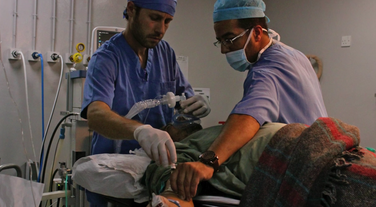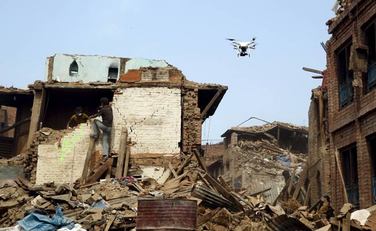JIC Global
Menu
MEDICAL REPORT
Snipers intentionally shot children in the head and adolescents in the genitals in order to mutiliate and punish civilians who were living in rebel-held areas. I witnessed schoolchildren who had the bone fragments of their obliterated classmates embedded in their skin after an airstrike.
I remember one child whose face was burned off and his left leg was shattered after an airstrike decimated a nearby market. About 30 people were killed that day, and scores more were wounded. These attacks happened so often that they all blur together in my mind. But I remember that child specifically because he was still alive, and he clutched his intestines which spilled out of his belly while others died around him. He died a few days later in our ICU. There was very little we could do to save him in a basement field hospital. I remember another teenager who lost both legs to a barrel bomb. He lost so much blood and showed up in shock. Medics saved his life by ligating blood vessels and giving him blood transfusions. When he woke up, he discovered his legs were missing. He saw the blankets flatten near his knees. His first reaction was to hyperventilate, and then he vomited. That is the Syria that I walked away from. That is the Syria that I never forget. You leave a piece of yourself behind with every trip you make—knowing all those people were simply being left to suffer and die. That is the closest I've ever been to sustained terror and dread—where the threat of death and dismemberment was pervasive and tangible. I was the last American doctor to leave Aleppo the day that it was surrounded by the Syrian government in July 2016. The vehicles that tried to follow us out on the Castello road were incinerated or they turned back. What ensued was a months-long medieval siege of starvation and bombardment, and then the fall of Aleppo. The local Syrians with whom I worked gave me hope—the nurses, the doctors, the schoolteachers—men and women who knew full well that the world had abandoned them. They, however, refused to abandon their local communities and worked in underground schools and hospitals until the very end. One morning a man brought his brother to the hospital for help. A bomb blast had obliterated the patient’s leg. His knee joint was an empty, open hole with no bones present from his thigh to his ankle. The only thing holding his leg in place was an external fixator. The wound was purulent and gangrenous, and I anticipated that he would lose his leg in a matter of days. I apologized to them both: there was nothing we could do. The soft tissue and osseous damage was too devastating. The man’s brother asked me why I had a strange accent. When he found out I was an American, he thanked me for my medical opinion. Then he thanked the United States of America for sending doctors to help inside his war-torn country at a time when Syrian doctors were being arrested and killed. His reaction to my presence resonated strongly with me. I was simply a surgeon born and raised in Chicago who showed up to help out and stand in solidarity with a good group of people. He was not the first Syrian to tell me this, but every time I go back I hear it. It makes me proud to be an American, and proud of the principles for which this nation stands. It taught me that there are ways to fight terrorism and oppression that don’t require bombs and bullets. Sometimes all you have to do is show up, help out, and represent. Samer (Sam) Attar, MD is an orthopedic surgeon who has volunteered on multiple occasions to provide care in Aleppo, Syria and refugee camps in Jordan. He has operated under conditions that we hope no military surgeon will have to encounter. Dr. Attar is an assistant professor of orthopedic surgery at Northwestern University. He is scheduled to speak at the 2017 Special Operations Medicine Scientific Assembly.
0 Comments
The humanitarian community, including non-government organizations (NGOs), Department of Defense, or other agencies, should consider fixed-wing vehicles with higher payloads, longer range, greater loiter time on target, more robust control systems, and higher operational ceiling. Although there is greater expense in developing and testing new platforms for humanitarian unmanned aerial vehicles (UAVs), there will be high payoffs in durability, life cycle, and versatility.
Examine the real-world request for UAV support during a humanitarian crisis: The 2008 Haiti earthquake. A call went out from NGOs to DOD for UAV support to determine the extent and magnitude of damage, especially in regions that were inaccessible by road. No Predators were re-tasked from the Middle East or South Asia. However, since 2015 the International Organization for Migration has used small fixed wing and rotor drones extensively to monitor camps and movement of internally displaced persons. But consider the appropriateness of an instrumented motorized glider for this kind of extreme disaster. Combine commercial, off-the-shelf technology (COTS) with remote or GPS guidance, and responders and planners would have invaluable real-time day, night, or inclement weather information; as well as a potential to broadcast public affairs radio messages, drop critical humanitarian supplies, or provide an area Internet link. On the other hand, given a need to deliver larger quantities of humanitarian goods, and perhaps protect itself or the recipients from attack by armed groups such as gangs or militias, an adapted hobby platform may have unique potential for medium, if not heavy, lift. Consider a World War Two bomber model for inspiration, with a “bomb bay” that would protect humanitarian supplies from the elements while reducing drag and increasing range, and providing precision parachute cargo delivery. For protection from ground threats, it could carry protective equipment, including non-lethal measures and smoke. Certainly, quadcopters are serving as carriers for the difficult logistical “last mile,” but if we are looking for a platform that can do work, gather information, and evade armed groups, we might do well to design purpose-built UAVs, and in some cases adapt COTS technology to innovative solutions for wicked humanitarian problems. One potential use for quadcopters that deserves some research and development attention is a vehicle equipped with biological sensors, beacon locators, and even a small amount of medical equipment, with a video communications link to a medical facility. In remote, hostile, and austere conditions, such a UAV could assist in rescue, including locating casualties with specialized sensors, and then direct rescuers or heavier-lift platforms and crews to the site. Importantly, we should develop technology to inform decision-makers whether the casualty is indeed viable, to take some of the ambiguity out of the risk matrix for combat or extreme weather rescue. Dr. Warner Anderson is a former Special Forces medic, group surgeon, and associate dean at the Joint Special Operations Medical Training Center. He is a specialist in internal medicine, emergency medicine, and global health. He has been an emergency department director, an emergency medical services medical director, and director of the International Health Division at the Office of the Assistant Secretary of Defense for Health Affairs. A combat veteran with two deployments to Iraq, he holds three Bronze Star Medals with one Valor Device, and a Purple Heart Medal. |

